
Window to Chiang Mai Thailand

Window to Chiang Mai Thailand
Elephant Care & Trekking Tours
Here are 36 active temples in the old city alone and many more in the greater city area. Should you be casually strolling down a narrow lane and you see a temple not listed here, take the time to walk in and look around, for every temple has something unique to offer. Many have special plaques that give a brief history at each location.
Wat Buppharam
See location at Google Maps: Wat Buppharam
(Thapae Road)
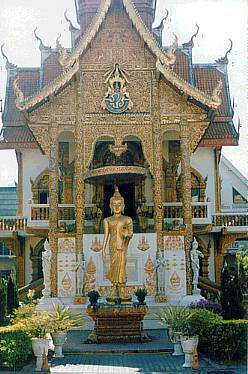
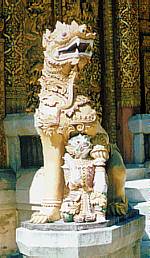 The temple was founded by King Muang Kaew in 1497. The Burmese-style chedi was rebuilt in 1958, and there is a well nearby which supplies holy water for anointing the King.
The temple was founded by King Muang Kaew in 1497. The Burmese-style chedi was rebuilt in 1958, and there is a well nearby which supplies holy water for anointing the King.
A small Lanna style viharn contains a large brick and stucco Buddha. Though over 300 years old, much that is seen today probably originates from a restoration at the end of the 19th century.
The mom - the guardian beasts at the entrance - were made in 1989, however.
The larger viharn (open only in the evening during chanting) goes back about 200 years and contains some mid- 20th century murals that show the Maha Rart in a Burmese style. The carved front door panels were completed in 1983.
The newest structure is the hall (ho monthian tham) with the pinnacled roof.
Abbot Phra Udom Kittimongkol had it built on the spot where an earlier wooden structure used to stand. The building took ten years to complete and was finished in 1996. With its mythical beasts, stucco reliefs, wood carvings and murals, it is a fine demonstration of contemporary religious art.
Inside the hall on the ground floor, murals show the Lanna twelve months' traditions.
Local artist Pornchai Jaimon included contemporary scenes in the details when he submitted this work for his degree thesis.
The second floor is heavily decorated and contains two large seated Buddha images. The white image is solid teak and was carved after a vision by King Naresuan in the late 16th century, when he defeated the Burmese forces near Muang Ngai. This vision is depicted in the carved wood panels on the east wall.
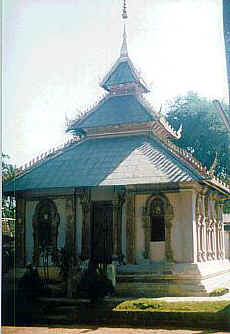
Wat Duang Di
See location at Google Maps: Wat Duang Di
(Phrapokklao Road)
This charming "hidden" temple has a compound shaded by some old longan trees. A small but unusual scripture repository decorated with stucco built in 1829 is located to the south of the main entrance to the viharn.
The tall viharn shows an Ayutthaya influence and has a very fine carved wooden gable. The massive wooden doors are dated 1929, but the main building is probably from the 19th century.
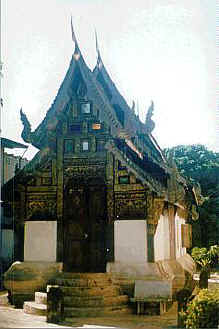
The inside of the viharn is simple, with crude murals between the windows depicting Buddhist bells.
The small ubosot next to the viharn is even older. According to an inscription at the base of one of the Buddha images in the viharn, the temple was formerly known as Wat Ton Mak Nua and dates back to King Muang Kaew at the beginning of the 16th century.
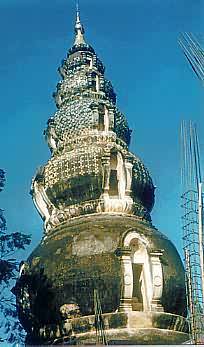
Wat Ku Tao
See location at Google Maps: Wat Ku Tao
(Off Sanam Kila Road).
This temple lies in a quiet compound containing several large trees. The main feature is the unusual chedi, which is shaped like a series of begging bowls stacked on top of each other. The origin of the chedi is a mystery. The name Ku suggests a charnel ground and Tao a round pot shape - thus it may have been built to keep the ashes of a Burmese noble in the late 16th or early 17th century.
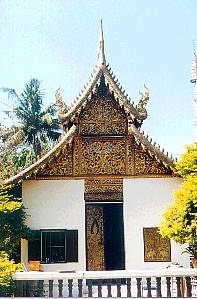
Wat Mahawan
See location at Google Maps: Wat Mahawan
(Thapae Road)
The origins of this temple may be traced back to at least the 17th century, making this one of the temples founded during the Burmese occupation.
Many of the temple buildings show a Burmese influence, particularly the viharn by the west wall. This was sponsored by a wealthy Burmese agent acting for teak companies, and was probably constructed in the late 19th century.
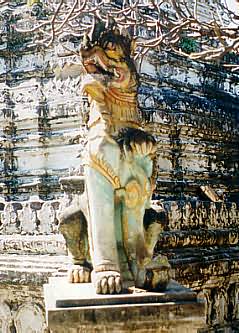 The compound also contains a Burmese-style chedi and large wooden scripture library that serves as the abbot's kuti. The small ubosot and large viharn next to it at the eastern end of the compound are typically Lanna. The viharn was renovated in 1957 and may have been first constructed around 1865.
The compound also contains a Burmese-style chedi and large wooden scripture library that serves as the abbot's kuti. The small ubosot and large viharn next to it at the eastern end of the compound are typically Lanna. The viharn was renovated in 1957 and may have been first constructed around 1865.
Bright modern murals may be seen on its walls. Panels on the north wall show the Vessantara Jataka and on the south wall show scenes of the Buddha meditating as he gained enlightenment.
Paintings on the wall behind the main Buddha image show a typical Bhodi tree with an idyllic scene depicting a state of nature that has long since disappeared from the northern hills.
Wat Pa Pao
See location at Google Maps: Wat Pa Pao
(Maninopharat Road)
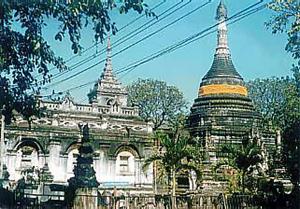 This is the finest example of a Shan temple in Chiang Mai. Though the Shan - style viharn is quite different from northern styles, the most striking feature is the sunken courtyard. It was built in 1883 by Shans who wished to have a place to practice their forms of Buddhist worship. Decorated gates tilt precariously and numerous statues of mythical beings give the place great charm. An unusual flat-roofed ubosot topped with a chedi has a vaulted interior which contains three Buddha images.
This is the finest example of a Shan temple in Chiang Mai. Though the Shan - style viharn is quite different from northern styles, the most striking feature is the sunken courtyard. It was built in 1883 by Shans who wished to have a place to practice their forms of Buddhist worship. Decorated gates tilt precariously and numerous statues of mythical beings give the place great charm. An unusual flat-roofed ubosot topped with a chedi has a vaulted interior which contains three Buddha images.
Wat Phan Tao
(Phrapokklao Road)
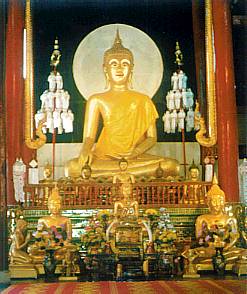 Once part of Wat Chedi Luang, the temple got its name from the "thousand furnaces" that were used to cast the images for the main temple. The large viharn is a rare example of a former ho kham - a royal hall. Originally on stilts and used as a residence by Chao Mahawong (r. 1846 - 54), the building was rebuilt as the viharn in 1876.
Once part of Wat Chedi Luang, the temple got its name from the "thousand furnaces" that were used to cast the images for the main temple. The large viharn is a rare example of a former ho kham - a royal hall. Originally on stilts and used as a residence by Chao Mahawong (r. 1846 - 54), the building was rebuilt as the viharn in 1876.
Flooding earlier last century damaged the building and concrete was used to replace some of the original structure. Though the central style dominates, the woodcarvings above the door and windows are Lanna. The gable overlooking Phrapokklao Road has fine woodcarvings. A curled sleeping dog beneath the peacock motif probably symbolizes the birth year of the royal sponsor. At the back of the temple compound is an aviary and fish pond.
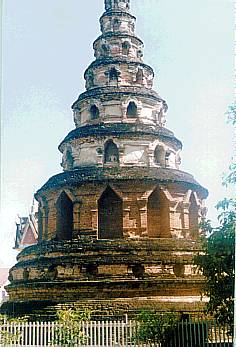
Wat Phuak Hong
See location at Google Maps: Wat Phuak Hong In Google Maps it is Phra Singh
(Off Samlan Road opposite Soi 7)
The gold on red panels of the gable on the viharn are typical of the Lanna style. However, the most distinctive feature of this temple is the round seven stepped chedi with 52 niches, which dates from 1517. Two other chedi in Chiang Mai, Chedi Prong and the chedi of Wat Rampoeng, have similar shapes.
Wat Prasat
See location at Google Maps: Wat Prasat
(Inthawororot Road)
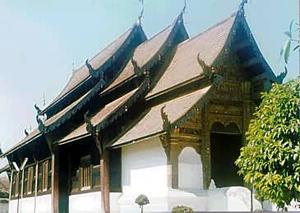 Wat Prasat, across Inthawororot Road to the north of Wat Phra Singh, dates back at least to the 16th century. The wooden viharn, which was built in 1823 and renovated in 1987, approaches a classic Lanna style.
Wat Prasat, across Inthawororot Road to the north of Wat Phra Singh, dates back at least to the 16th century. The wooden viharn, which was built in 1823 and renovated in 1987, approaches a classic Lanna style.
The pleasing external form is matched by the artifacts inside the viharn. At the back of the temple the space for the altar is replaced by a highly decorated entrance to a short tunnel leading to the chedi. A number of meter high images with red painted robes sit on the raised pedestal on either side of the entrance. The image closest to the entrance on the north side is bronze (the others are stucco) and is - dated 1590, which was during the period of Burmese rule.
The side walls of the back of the viharn also have murals in red and gold that are thought to date back to the 1820's, making them the same age as the murals in the Viharn Lai Kham in Wat Phra Singh. The decorated wooden pulpit is also worth studying.
Wat Saen Fang
See location at Google Maps: Wat Saen Fang
(Thapae Road)
The temple's origins go back to the 14th century, but the architecture is late 19th century Burmese. This can clearly be seen with the chedi and the ubosot on the west side of the compound. The viharn with its elaborate carved wooden front is of particular note as it was part of the former hall (ho kham) of Chao Kawilorot (r.1856 - 1870). His successor, Chao Inthanon ordered it reconstructed for use as the viharn in 1878. The old scripture library west of the chedi was built in 1869.
Wat U-Mong Maha Therachan
See location at Google Maps: Wat U-Mong Maha Therachan
(Ratchaphakhinai Road)
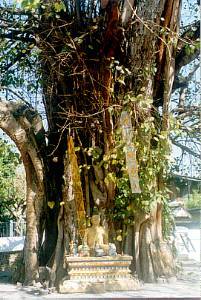 Like many temples this one looks new, but its origins go back to 1367. The name "Maha Therachan" is said to have come from a renowned monk who was its abbot (see Wat U-Mong Suan Puttha-tham). Two old Lanna-style chedis are located in the compound.
Like many temples this one looks new, but its origins go back to 1367. The name "Maha Therachan" is said to have come from a renowned monk who was its abbot (see Wat U-Mong Suan Puttha-tham). Two old Lanna-style chedis are located in the compound.
The viharn contains some modern murals typical of the Rattanakosin style and show the Vessantara Jataka. The story begins above the main door and continues clockwise on the side walls of the viharn.
The small ubosot is guarded by two fierce beasts called mom. The same artist also did the stucco work inside and painted the side walls with bright new murals depicting scenes from the life of the Buddha. The ubosot also has finely carved wooden doors and windows. The entire renovation work to the ubosot was completed in the early 1990's and the whole is a good example of contemporary Lanna temple art.
The current abbot has no objection to women entering the ubosot as long as there are no ceremonies in process.
See also:
Crystal Sons The Maha Rart - the Great Birth Stucco The Naga and Makara
Sightseeing Guide
City Temples